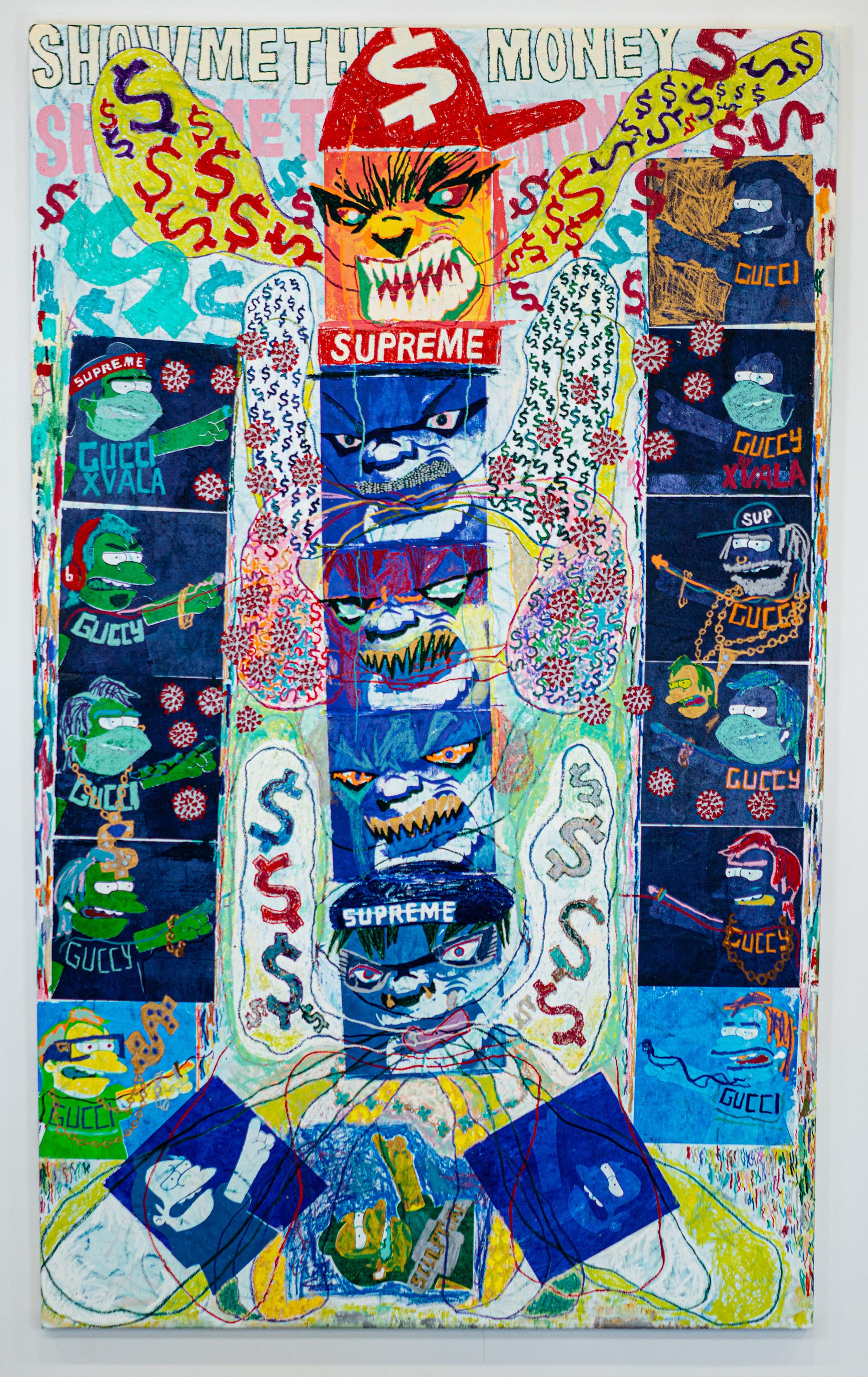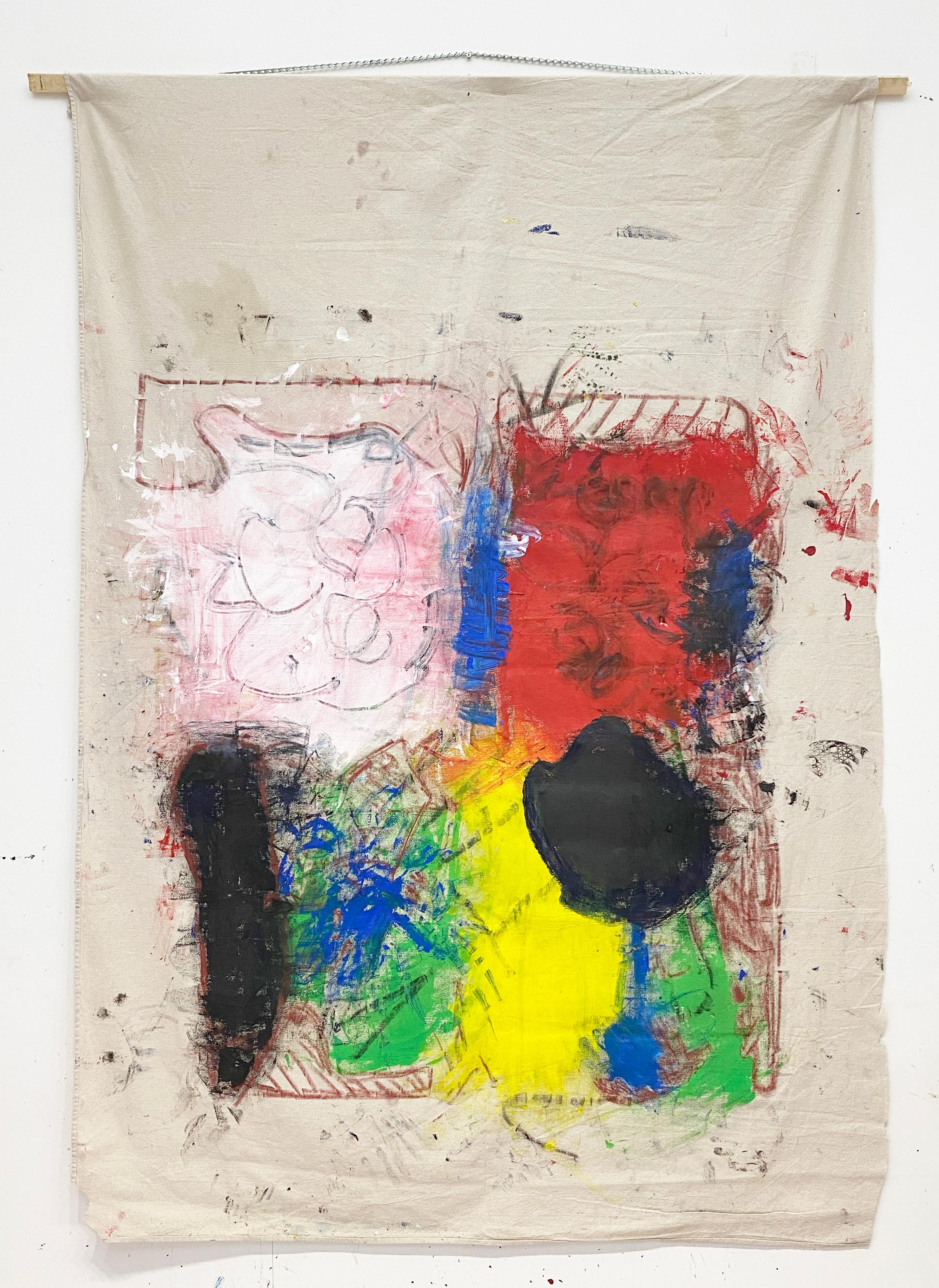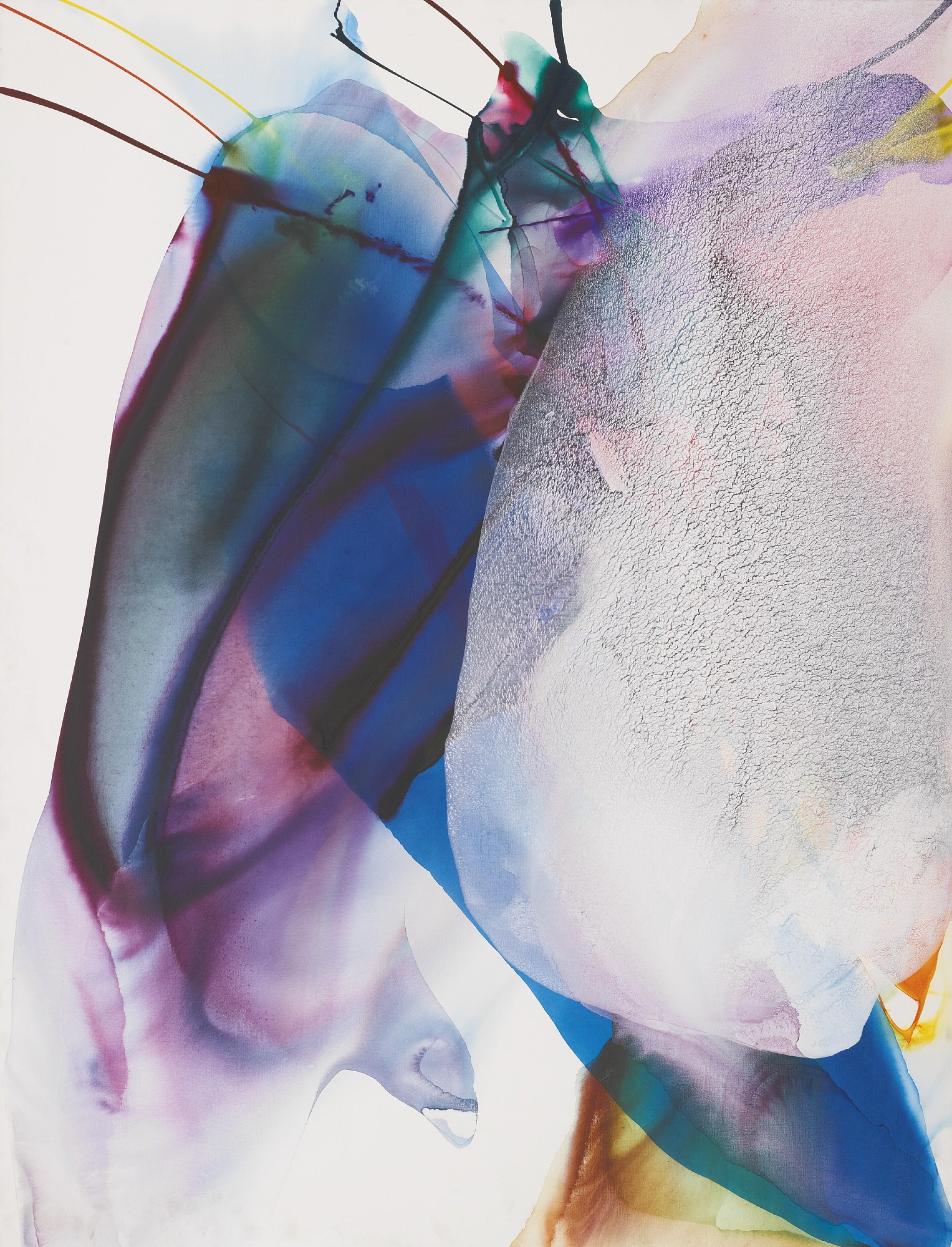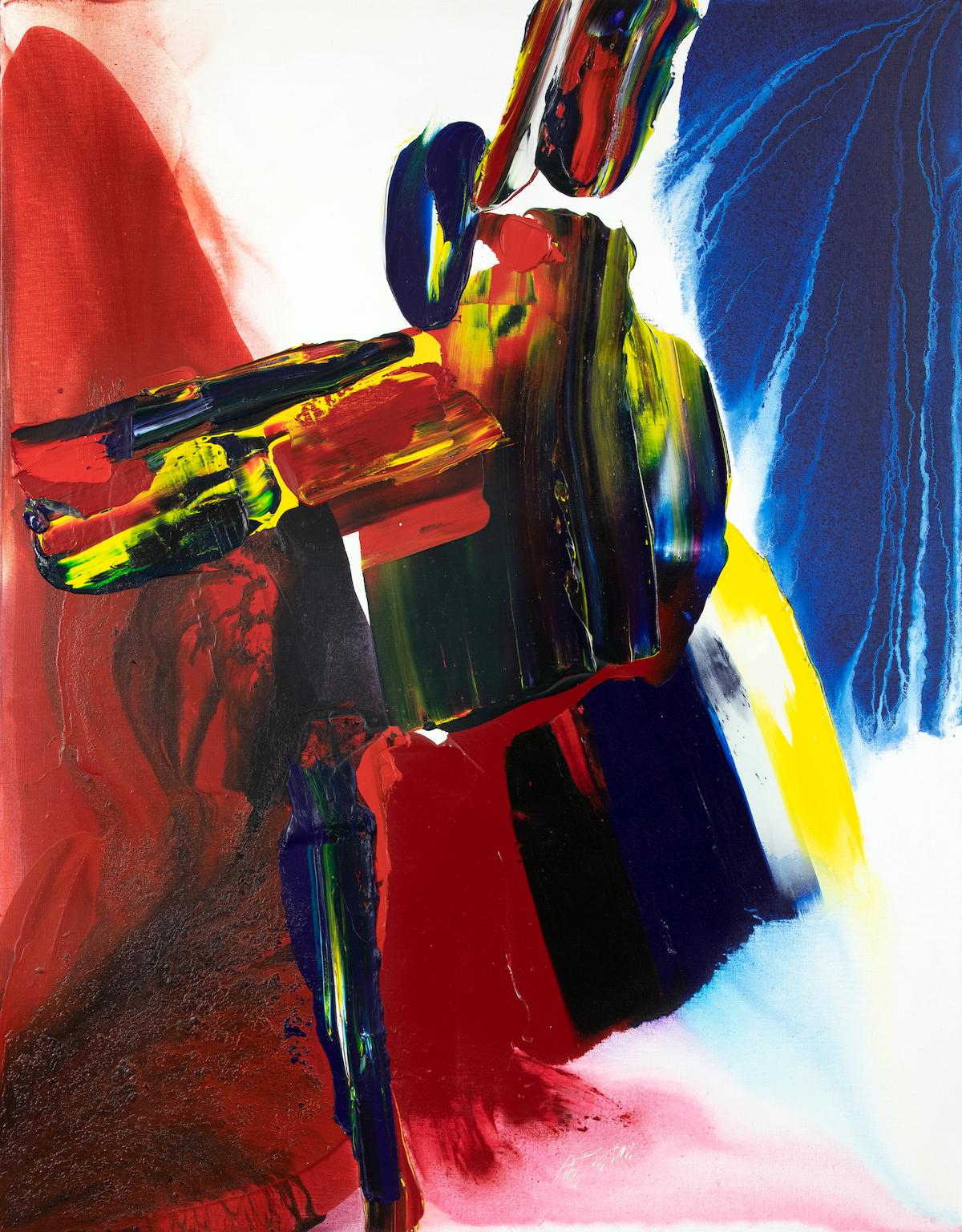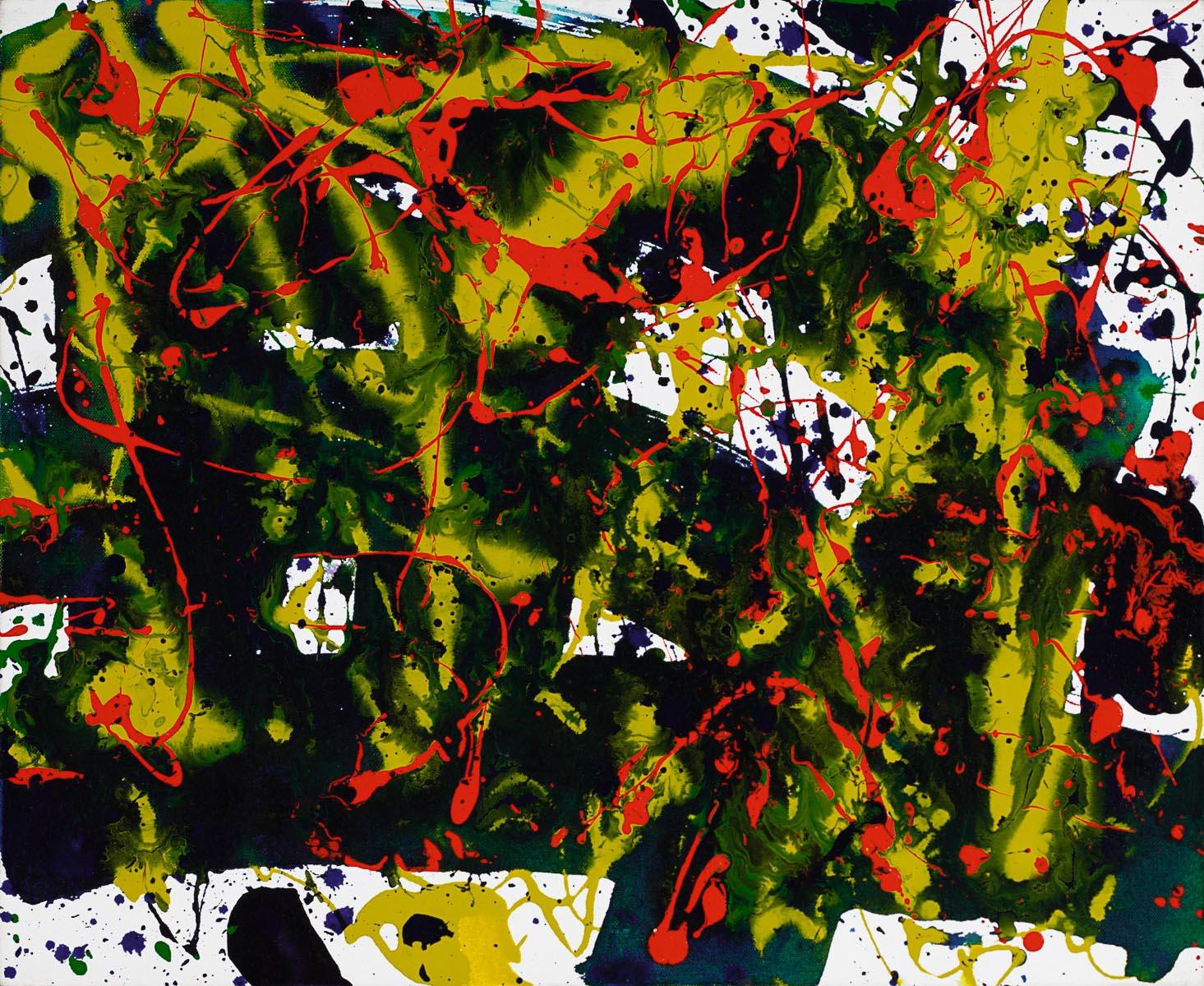Items Similar to "Night Road" Gerome Kamrowski, Abstract Expressionism Surrealism, Purple Impasto
Want more images or videos?
Request additional images or videos from the seller
1 of 9
Gerome Kamrowski"Night Road" Gerome Kamrowski, Abstract Expressionism Surrealism, Purple Impasto1966
1966
About the Item
Gerome Kamrowski (1914 - 2004)
Night Road, 1966
Acrylic on canvas
58 1/4 x 96 1/4 inches
Signed and dated
Provenance:
The Artist
The Kamrowski Estate (by family descent in 2004)
Exhibited:
The Detroit Institute of Arts, Detroit, Michigan, 56th Exhibition for Michigan Artists, November 18 - December 31, 1966, no. 32, illustrated (Night Road was the winner of the "Phyllis King Weiner Memorial Prize" at this exhibition).
Ann Arbor, University of Michigan Museum of Art, Gerome Kamrowski: A Retrospective Exhibition, August 30 - October 16, 1983, no. 70, illustrated.
Tarpon Springs, Florida, Leepa-Rattner Museum of Art, St. Petersburg College, Gerome Kamrowski: An American Surrealist, September 8 - October 27, 2002, no. 23.
Chelsea, Michigan, River Gallery, Gerome Kamrowski: 1914-2004, A Memorial Retrospective, October 30 - December 5, 2004.
Gerome Kamrowski was born in Warren, Minnesota, on January 19, 1914. In 1932 he enrolled in the Saint Paul School of Art (now Minnesota Museum of American Art - MMAA), where he studied with Leroy Turner, and Cameron Booth. Both Turner and Booth had been students of Hans Hofmann, and were also associated with the Abstraction-Création group in Paris. It was from these peers that Kamrowski was introduced to a "kind of expressionist cubism." In 1933 Kamrowski was awarded a scholarship to the Art Students League, where he would study in New York under Hans Hofmann. Unfortunately, immigration problems had prevented Hofmann from assuming his post. Nevertheless, Kamrowski decided to remain in New York for a short time, to attend classes taught by George Grosz. After a few weeks, he returned to St. Paul, and found a position in the mural painting division of the Minnesota FAP/WPA (Works Progress Administration). In 1936 he contributed “Synthetic Cubist Style” frescoes in the Northrup Auditorium of the University of Minnesota.
In 1937 Kamrowski went to Chicago to study under László Moholy-Nagy and Alexander Archipenko at the New Bauhaus (now Illinois Institute of Technology's Institute of Design). There he was exposed to new and interesting ideas regarding the role of nature in art and the "geometric basis of natural form".
In 1938 Kamrowski received a Guggenheim fellowship to attend Hans Hofmann's summer school in Provincetown, Massachusetts. He then relocated to New York where he met William Baziotes. Together they shared a fascination in Surrealist automatic writing, and both artists explored its possibilities in their paintings. Kamrowski was particularly drawn to Surrealism's fundamental appeal of intuition over intellect. He was interested seeking a process that "binds all things together...a kind of cosmic rhythm".
Throughout the late 1930s and early 1940s while living in New York, Kamrowski became an integral part of the emerging surrealists. In 1942, the artist Roberto Matta attempted to form a group of artists to investigate new applications for Surrealist methods. He invited Kamrowski, along with William Baziotes, Jackson Pollock, Peter Busa, and Robert Motherwell to join. Like Kamrowski, the others were more interested in process than in subject matter—the foundation of Matta's art—and the group soon dissolved. But no matter how short lived the collaboration was, this group was the kernel of the open-ended movement that was referred to as abstract surrealism and would over time prove to be the beginnings of abstract expressionism.
It was during this time, the winter of 1939/1940, that an amazing collaboration was made. Kamrowski and two of his contemporaries, William Baziotes and Jackson Pollock, came together and began to paint. The description of this historic event is described as follows in "Pollock" by Ellen G. Landau: "For a number of years, Kamrowski had been involved with Surrealist image-coaxing techniques. In a letter to B.H. Friedman, Kamrowski recalled that one day he, Pollock, and Baziotes were fooling around' with quart-cans of lacquer paint. Baziotes asked if he could use some 'to show Pollock how the paint could be spun around.' He then looked around the room for something to work on, and a canvas that Kamrowski had 'been pouring paint on and was not going well' was handy, so Baziotes began to throw and drip' white paint on it. He next gave the dripping palette knife to Jackson, who with his intense concentration' started flipping the paint with abandon. ' According to Kamrowski, after all had a chance to play, Baziotes identified the spiral forms he had created as 'birds' nests, ' but Pollock refused to interpret his spots." This painting was a pivotal work, showing the transition from, and fusion of, Surrealism to Action Painting and Abstract Expressionism.
In 1947, Kamrowski was invited to the Surrealist Exhibition in Paris by Surrealist leader André Breton. Breton said of him, "Of all the young painters whose evolution I have been able to follow in New York during the last years of the war, Gerome Kamrowski is the one who has impressed me far the most by reason of the "quality" and sustained character of his research. Among all the newcomers there, he was the only one...tunneling in a new direction..."
In the 1940s Kamrowski relocated to Ann Arbor, Michigan in order to teach at the University of Michigan School of Art. It was a career that would span thirty-eight years, and would encourage countless others to push their artistic boundaries. Professor Jon Rush, at the University's School of Art and Design, stated: "As a teacher, Professor Kamrowski admonished his students to experiment and push the boundaries of their art. He urged them to be unafraid of failure and consider it a natural part of the creative process," and says "Above all, he stressed the importance of finding one's own path and that it would take hard work and dedication to achieve that. He was a natural teacher who related well to students because he himself never stopped being one."
Teaching became a second passion. Over the years, Kamrowski's energy and drive never faltered, and his style continued to evolve dynamically from the abstract intellectual exercises of the past to colorful 3-D pieces often made of glass, cement, and random found objects. He worked every day and exhibited steadily in Michigan and elsewhere. He once said, "Michigan has been good to me, don't misunderstand me, but on the other hand I have a certain amount of contempt for it."
He cited architects Antoni Gaudi and Simon Rodia as inspirations.
- Creator:Gerome Kamrowski (1914-2004, American)
- Creation Year:1966
- Dimensions:Height: 58.25 in (147.96 cm)Width: 96.25 in (244.48 cm)
- Medium:
- Movement & Style:
- Period:
- Condition:
- Gallery Location:New York, NY
- Reference Number:1stDibs: LU1841210485372
Gerome Kamrowski
Gerome Kamrowski was born in Warren, Minnesota, on January 19, 1914. In 1933 Kamrowski was awarded a scholarship to the Art Students League, where he would study in New York under Hans Hofmann. Kamrowski decided to remain in New York for a short time, to attend classes taught by George Grosz. After a few weeks, he returned to St. Paul, and found a position in the mural painting division of the Minnesota WPA. In 1937 Kamrowski went to Chicago to study under László Moholy-Nagy and Alexander Archipenko at the New Bauhaus. There he was exposed to new and interesting ideas regarding the role of nature in art and the "geometric basis of natural form". In 1938 Kamrowski received a Guggenheim fellowship to attend Hans Hofmann's summer school in Provincetown, Massachusetts. He then relocated to New York where he met William Baziotes. Together they shared a fascination in Surrealist automatic writing, and both artists explored its possibilities in their paintings. Kamrowski was particularly drawn to Surrealism's fundamental appeal of intuition over intellect. He was interested seeking a process that "binds all things together...a kind of cosmic rhythm". Throughout the late 1930s and early 1940s while living in New York, Kamrowski became an integral part of the emerging surrealists. In 1942, the artist Roberto Matta attempted to form a group of artists to investigate new applications for Surrealist methods. He invited Kamrowski, along with William Baziotes, Jackson Pollock, Peter Busa, and Robert Motherwell to join. No matter how short lived the collaboration was, this group was the kernel of the open-ended movement that was referred to as abstract surrealism and would over time prove to be the beginnings of abstract expressionism. It was during this time, the winter of 1939/1940, that an amazing collaboration was made. Kamrowski and two of his contemporaries, Baziotes and Pollock, came together and began to paint. This painting was a pivotal work, showing the transition from, and fusion of, Surrealism to Action Painting and Abstract Expressionism. In 1947, Kamrowski was invited to the Surrealist Exhibition in Paris by Surrealist leader André Breton. Breton said of him, "Of all the young painters whose evolution I have been able to follow in New York during the last years of the war, Kamrowski is the one who has impressed me far the most by reason of the "quality" and sustained character of his research." In the 1940s Kamrowski relocated to Ann Arbor, Michigan in order to teach at the University of Michigan School of Art. It was a career that would span 38 years, and would encourage countless others to push their artistic boundaries. Teaching became a second passion. Over the years, Kamrowski's energy and drive never faltered, and his style continued to evolve dynamically from the abstract intellectual exercises of the past to colorful 3D pieces often made of glass, cement, and found objects. He worked every day and exhibited steadily in Michigan and elsewhere.
About the Seller
5.0
Platinum Seller
These expertly vetted sellers are 1stDibs' most experienced sellers and are rated highest by our customers.
Established in 2021
1stDibs seller since 2022
61 sales on 1stDibs
Typical response time: 1 hour
- ShippingRetrieving quote...Ships From: New York, NY
- Return PolicyA return for this item may be initiated within 3 days of delivery.
More From This SellerView All
- "Untitled" Sherron Francis, Female Abstract Expressionism, Red Green Color FieldBy Sherron FrancisLocated in New York, NYSherron Francis Untitled, circa 1975 Acrylic on canvas 90 x 64 inches Artists such as Helen Frankenthaler, Morris Louis, Dan Christensen, and Sam Francis are already well-known name...Category
1970s Abstract Expressionist Abstract Paintings
MaterialsCanvas, Acrylic
- "Untitled" Sherron Francis, Female Abstract Expressionism, Blue Red Color FieldBy Sherron FrancisLocated in New York, NYSherron Francis Untitled, 1975 Acrylic on canvas 96 x 66 inches Artists such as Helen Frankenthaler, Morris Louis, Dan Christensen, and Sam Francis are already well-known names. How...Category
1970s Abstract Expressionist Abstract Paintings
MaterialsCanvas, Acrylic
- "Sonic Lark" Sherron Francis, Female Abstract Expressionism, Long Color FieldBy Sherron FrancisLocated in New York, NYSherron Francis Sonic Lark, 1974 Signed, titled and dated on the reverse Acrylic on canvas 24 x 109 1/2 inches Artists such as Helen Frankenthaler, Morris Louis, Dan Christensen, an...Category
1970s Abstract Expressionist Abstract Paintings
MaterialsCanvas, Acrylic
- "Noble O" Sherron Francis, Female Abstract Expressionism, Black Color FieldBy Sherron FrancisLocated in New York, NYSherron Francis Noble O, 1976 Signed, titled and dated on the reverse Acrylic and mixed media on canvas 57 x 21 inches Artists such as Helen Frankenthaler, Morris Louis, Dan Christe...Category
1970s Abstract Expressionist Abstract Paintings
MaterialsCanvas, Acrylic
- "Untitled" Calvert Coggeshall, Abstract Expressionism Hard-edge StripesLocated in New York, NYCalvert Coggeshall Untitled, circa 1975 Oil on canvas 50 x 40 inches Calvert Coggeshall worked as an abstract painter and interior designer primari...Category
1970s Abstract Expressionist Abstract Paintings
MaterialsCanvas, Acrylic
- "Untitled" Sherron Francis, Female Abstract Expressionism, Black Color FieldBy Sherron FrancisLocated in New York, NYSherron Francis Untitled, 1977 Signed and dated on the reverse Acrylic and mixed media on canvas 93 x 42 inches Artists such as Helen Frankenthaler, Morris Louis, Dan Christensen, a...Category
1970s Abstract Expressionist Abstract Paintings
MaterialsAcrylic, Canvas
You May Also Like
- 'Show Me the Money: Ultra Luxury Edition, ' by XVALA, Mixed Media PaintingBy XVALALocated in Oklahoma City, OKThis large 119" x 72" mixed media painting by the artist, XVALA, is from his series 'Pandemic Collection: 8' and depicts bright colorful cartoon chara...Category
2010s Abstract Expressionist Figurative Paintings
MaterialsCanvas, Mixed Media, Acrylic, Oil Crayon, Screen
- JP TP : abstract expressionist work of artLocated in New York, NYAbstract expressionist work of art by Joseph Hicks. Joseph Hicks’s works are bright and colorful, full of life and creativity. His canvases are full of energy and dynamism due to t...Category
2010s Abstract Expressionist Abstract Paintings
MaterialsCanvas, Oil Crayon, Mixed Media, Acrylic
- 'Shattered Atlas: The Modern Burden' - Abstract Cubism Portrait by MasriBy Masri HayssamLocated in Carmel, CAIn "Shattered Atlas: The Modern Burden," the artist Masri presents a 40" x 30" mixed media canvas that epitomizes 'Shattered Cubism,' a style that fragments reality into geometric fo...Category
Early 2000s Abstract Expressionist Portrait Paintings
MaterialsCanvas, Mixed Media, Oil, Acrylic
- Phenomena West Mantle (1968). Acrylic on canvas painting by Paul JenkinsBy Paul JenkinsLocated in Hong Kong, HKAn emblematic example of Paul Jenkins mastery. It is not by hazard that Phenomena West Mantle was chosen as the cover of the catalogue for the groundbreaking exhibition "Paul Jenkins...Category
1960s Abstract Expressionist Abstract Paintings
MaterialsAcrylic, Canvas
- Phenomena Greet by Day by Paul Jenkins - Abstract Expressionist paintingBy Paul JenkinsLocated in London, GBPhenomena Greet by Day by Paul Jenkins (1923-2012) Acrylic on canvas 146 x 114.3 cm (57 ½ x 45 inches) Signed lower right, Paul Jenkins Executed in 1994-1996 Provenance: Private collection, New York (acquired directly from the artist) Stern Pissarro Gallery, London Private collection, Netherlands Artist biography Born at Kansas City in Missouri (USA), the multi-media artist, poet and playwright Paul Jenkins studied at the Kansas City Art Institute and the Art Students League in New York City. After his discharge from military service at the end of February 1946, he briefly studied playwriting with dramatist George McCalmon at the Carnegie Institute of Technology in Pittsburgh. Thereafter, Jenkins spent four years studying with Japanese American artist Yasuo Kuniyoshi in New York City. His first solo exhibitions were held at Studio Paul Facchetti in Paris in 1954 and the Martha Graham Gallery in New York City in 1956. Over the past thirty years, numerous retrospectives have been curated across the globe and Jenkins’ work can found in national collections from Europe and the United States to Israel, Australia and Japan. The diversity of his work springs from Jenkins’ wealth of eclectic influences. Some of his earliest works included what he called "interior landscapes" influenced by ancient natural forms like the caves he visited in the Ozark Mountains in his native-Missouri. Frequent student visits to the Frick Collection in New York fostered a love of the great masters: Bellini, Holbein, Vermeer, Rembrandt, de la Tour, Turner and Goya. In compliment, lingering student visits to the renowned Eastern collection of the Nelson-Atkins Museum of Art in Kansas City evoked powerful sympathy for a monumental Chinese fresco...Category
1990s Abstract Expressionist Abstract Paintings
MaterialsCanvas, Acrylic
- Untitled, 1994 (SFP94-36)By Sam FrancisLocated in Greenwich, CTUntitled, 1994 (SFP94-36) is an acrylic painting on canvas, from Francis' 'Last Works' collection. The canvas is 18 x 22 inches and stamped verso with the Sam Francis estate stamp. F...Category
20th Century Abstract Expressionist Paintings
MaterialsCanvas, Acrylic
Recently Viewed
View AllMore Ways To Browse
Surrealism Art
Two Roads
All Roads
Contemporary Surrealism
Contemporary Abstract Expressionism
Surrealism Painting
Surrealism And Painting
Abstract Expressionism Framed
Abstract Expressionism Art Framed
Transition Abstract
Vintage Surrealism Art
Framed Abstract Expressionism Paintings
Abstract Surrealism
American Surrealism
Retro Surrealism Art
Impasto Abstract
Impasto Abstract Painting
Black Abstract Expressionism
